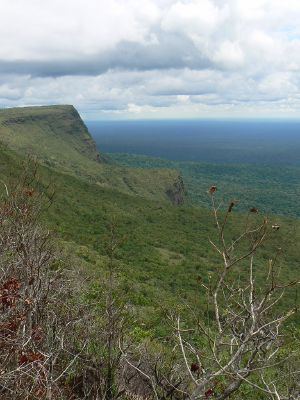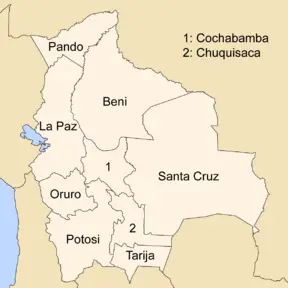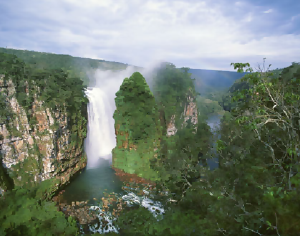Difference between revisions of "Noel Kempff Mercado National Park" - New World Encyclopedia
Vicki Phelps (talk | contribs) |
Vicki Phelps (talk | contribs) |
||
| Line 80: | Line 80: | ||
* Allow visitors to enjoy its natural beauty | * Allow visitors to enjoy its natural beauty | ||
* Help local residents to improve their lifestyle | * Help local residents to improve their lifestyle | ||
| + | ==Looking to the future== | ||
| + | Through a unique partnership, the government of [[Bolivia]], the Friends of Nature Foundation, The Nature Conservancy, and three energy companies (American Electric Power, PacifiCorp, and BP Amoco) have teamed up to jointly implement the $11 million Noel Kempff Mercado Climate Action Project—the largest forest-based carbon project in the world. | ||
==External links== | ==External links== | ||
Revision as of 02:43, 7 January 2009
| Noel Kempff Mercado National Park* | |
|---|---|
| UNESCO World Heritage Site | |

| |
| State Party | |
| Type | Natural |
| Criteria | ix, x |
| Reference | 967 |
| Region** | Latin America and the Caribbean |
| Inscription history | |
| Inscription | 2000 (24th Session) |
| * Name as inscribed on World Heritage List. ** Region as classified by UNESCO. | |
| Noel Kempff Mercado National Park | |
|---|---|
| IUCN Category II (National Park) | |
| | |
| Location: | Santa Cruz Department, Bolivia |
| Area: | 15,234 km² |
| Established: | June 28, 1979 |
Noel Kempff Mercado National Park is a national park in the northeastern portion of the Santa Cruz Department of Bolivia, on the border with Brazil.
The park was created on June 28, 1979. Its original name was Parque Nacional Huanchaca, but it was changed to honor the late Professor Noel Kempff Mercado for his research and discoveries in the park.
Despite its natural beauty, lack of pollution, and isolation, the park still faces several threats, including:
- Turtle hunting
- Fishing
- Industrialized forest fires
- Illegal forest exploitation
- Drug trafficking
- Financing its projects
Geography
The Noel Kempff Mercado National Park spans 5,880 square miles (15,234 km²) in northeastern Bolivia, in one of the most biologically diverse areas in the world. Bolivia is known for its diversity in climate, fauna, and flora. In the area of Santa Cruz de la Sierra the weather is very humid and warm. The normal temperature is between 25 and 29°C. The rainfall is annually roughly 1,500 mm. This area, near the border of Brazil, has a lot of rainforest and tropical animals.
The site contains an array of habitat types including evergreen rainforests, palm forests, cerrado, swamps, savannas, gallery forests, and semi-deciduous dry forests. The cerrado habitats found on the Huanchaca Meseta have been isolated for millions of years and thus contain a high diversity of plant and animal species, including viable populations of many globally threatened large vertebrates.
Flora
It is estimated that the park has approximately 4,000 species of vascular plants. There exist diverse types of bromelias, passifloras, heliconias, aráceas, and palm trees. There are also important types of wood like the "Mara." The area includes five important ecosystems ranging from Amazonian rainforest, gallery forest and semi-deciduous tropical forest to flooded savanna and dry cerrado.
Fauna
The park is home to more than 130 species of mammals, (including rare river otters, river dolphins, tapirs, spider and howler monkeys, the giant armadillo, giant anteaters and endangered jaguars, including a population of black jaguars), 620 species of birds (including 9 species of macaw, possibly the highest number of species in any one protected area), and 70 species of reptiles, including black caiman and snakes.
There are also more than 617 species of birds (20 percent of the all bird species in South America). Recent studies say that these numbers would increase if migratory birds were included.
The park has 347 species of insects, including some of the rarest in the world, many of which have not yet been studied. Butterflies in a range of colors can be found.
Principal goals
The general objective of the park's formation is to protect this natural area of great diversity that has not been industrialized and is not polluted.
Specific goals are to:
- Guarantee protection of the ecosystems
- Foster scientific research
- Allow visitors to enjoy its natural beauty
- Help local residents to improve their lifestyle
Looking to the future
Through a unique partnership, the government of Bolivia, the Friends of Nature Foundation, The Nature Conservancy, and three energy companies (American Electric Power, PacifiCorp, and BP Amoco) have teamed up to jointly implement the $11 million Noel Kempff Mercado Climate Action Project—the largest forest-based carbon project in the world.
External links
- Official UNESCO website entry
- Climate Action Program
- World Conservation Monitoring Centre
- Short amateur video of waterfall Arco Iris in Noel Kempff Mercado National Park
- Short amateur video of waterfall Ahlfeld in Noel Kempff Mercado National Park
| |||||||
Credits
New World Encyclopedia writers and editors rewrote and completed the Wikipedia article in accordance with New World Encyclopedia standards. This article abides by terms of the Creative Commons CC-by-sa 3.0 License (CC-by-sa), which may be used and disseminated with proper attribution. Credit is due under the terms of this license that can reference both the New World Encyclopedia contributors and the selfless volunteer contributors of the Wikimedia Foundation. To cite this article click here for a list of acceptable citing formats.The history of earlier contributions by wikipedians is accessible to researchers here:
The history of this article since it was imported to New World Encyclopedia:
Note: Some restrictions may apply to use of individual images which are separately licensed.


